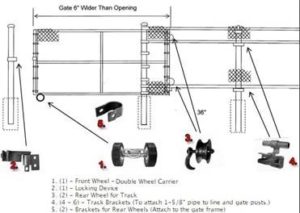Rolling gates
Got hills & valleys? A rolling gate is your best choice.
A rolling gate is a type of slide gate. The most popular slide gate is a cantilever gate. Cantilever gates use rollers that are attached to support posts with no rollers or wheels touching the ground. The cantilever gate is cantilevered over the opening. It is the perfect option for automation as it does not come in contact with the ground and operates easily under adverse weather conditions. Its travel is controlled entirely by the rollers that guide it.
Unfortunately, cantilever gates are typically elevated off the ground due to guide wheels and rollers placed underneath the gate frame to support it. Cantilever gates must be installed level. Not only is this required in accordance with ASTM 2200; it is critical relative to providing a safe installation. Cantilever gates are generally very heavy and roll freely with the use of sealed ball bearing rollers. A slight slope in the gate can cause it to take-off as it rolls downhill. This can create a very deadly situation if the gate where to hit a pedestrian. The elevations under the full travel of the gate must be evaluated when considering a cantilever gate. If the elevations at any point of the travel of the gate are greater than the elevation at the gate support posts; the gate must be raised to maintain a level installation and not bottom-out during travel. For these reasons, cantilever gates are not a good option when you have rising slopes and valleys in the travel of the gate.
If your opening is sloped across the opening or if you have a rising elevation on the side the opening where the gate is to be stored; your best option is a rolling slide gate. Rolling gates use rear guide wheels attached to the gate that run on a track attached to the adjoining fence or series of support posts. The track will follow the slope or rising elevation thus the gate will also follow this slope as it travels along the track. At the front of the gate is a wheel assembly. This assembly is located at the bottom of the gate and travels on the ground across the opening. Thus, if your opening slopes the gate will travel with the slope as it opens or closes. With the combination of the rear guide wheels and front wheel assembly, the gate will travel through a sloped opening and will open and rise with a rising elevation.
Unfortunately, rolling gates are not a good option for automation. With the wheel assembly travelling on the ground; variations in slope, ground conditions and severe weather can affect the travel thus making the final destination unknown. A rolling gate should be opened and closed by human contact that control the direction of the gate when closing and overcome site or weather conditions.
Rolling gates use a wide range of hardware that include a front wheel assembly or double wheel carrier, locking device, rear wheels assemblies and track brackets. Installation and the cost of the hardware make a rolling gate not as a competitively priced as a swing gate but slightly less than a cantilever gate.

